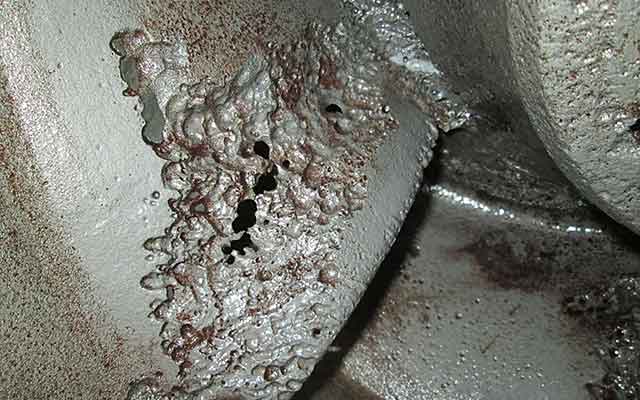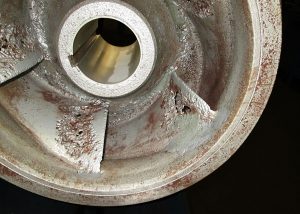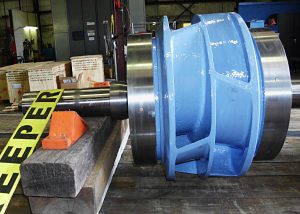Authors: Pharic Smith, Head of Engineering, Parts, Retrofits & Nuclear for EMEA region at Sulzer UK, and Thomas Kraenzler, Head Global Core Technology Materials for Sulzer Pumps
Industrial processes across the globe require pumps to operate reliably and efficiently. The latest pump designs and coating technologies offer significant improvements in the long term performance of industrial pumps. By minimizing the effects of corrosion and erosion, users can enhance productivity and reduce running costs.
Continued research into the processes that degrade pump performance is being matched by the development of better application techniques for protective coatings. By gaining a better understanding of both the pumping process and the factors that affect it, end users can make significant improvements in their maintenance strategies.
Affected applications
Almost every industrial process involving liquids will include a pump at some point. From deep sea oil and gas to DNA sequencing, pumps are required to perform a vast range of tasks. However, no matter what the design or the size of the pump, central to every application is reliability and efficiency – minimizing down time and running costs is essential to modern industry.
For those working with large industrial pumps, often operating in harsh environmental conditions, maintaining pump performance in the face of a continuous threat from corrosion and erosion can be a particular challenge. With increased knowledge of these processes and the techniques used to tackle them, it is possible to implement a more cost effective pump refurbishment program.
Corrosion:
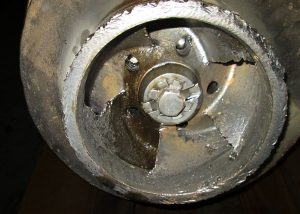 Corrosion is commonly defined as a chemical reaction between the component surface and the reacting fluid passing through a pump. In general a distinction is drawn between general or uniform corrosion and localized corrosion like pitting and crevice corrosion. Non-stainless materials suffer mainly from uniform corrosion whereas metals forming oxide layers that adhere to and passivate the surface are prone to localized corrosion.
Corrosion is commonly defined as a chemical reaction between the component surface and the reacting fluid passing through a pump. In general a distinction is drawn between general or uniform corrosion and localized corrosion like pitting and crevice corrosion. Non-stainless materials suffer mainly from uniform corrosion whereas metals forming oxide layers that adhere to and passivate the surface are prone to localized corrosion.
Flow Accelerated Corrosion:
Flow accelerated corrosion (FAC) describes the removal of the protective oxide layer on a metal. The speed of this process is affected by the oxygen content, the flow velocity and, to some extent, the chloride content. The formation of a calcareous layer due to high carbonate hardness of the water reduces or even prevents FAC.
The influence of oxygen can be seen in the following example: Water with an oxygen content of less than 20 ppb (parts per billion) and a flow velocity around 15 m/s will typically see a corrosion rate around 0.01 mm/year. However, increased oxygen content can see the corrosion rate rise to several mm/year, which will present a significant challenge to the process.
Fortunately FAC only poses a real issue for low carbon steels and cast iron. Increasing the chromium content or using stainless steel will largely eliminate the vulnerability to flow accelerated corrosion.
Erosion:
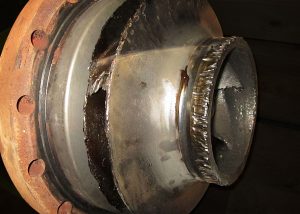 Pumps that are used to transfer fluids containing abrasive substances, such as sand, can experience significant levels of erosion, especially in areas with high flow velocities. This can be seen in the oil and gas industry where injection pumps are employed to force water back into the oil field and thus maintain the pressure which is needed to lift the oil to the surface. The entrained sand particles act as an abrasive and the high working pressures only serve to compound the issue.
Pumps that are used to transfer fluids containing abrasive substances, such as sand, can experience significant levels of erosion, especially in areas with high flow velocities. This can be seen in the oil and gas industry where injection pumps are employed to force water back into the oil field and thus maintain the pressure which is needed to lift the oil to the surface. The entrained sand particles act as an abrasive and the high working pressures only serve to compound the issue.
From a pure design standpoint, pump manufacturers in this field effectively have two options to minimize the erosion:
i) Reduce the flow velocities in every part of the pump
or
ii) Design the pump in such a way that the flow velocities through the close-running clearances are low.
However, in most cases the specifications required for the application will prevent either of these solutions from being implemented. Coatings with high erosion resistance in selected areas of the pump are a proven solution in these applications.
Erosion-Corrosion:
In operating conditions where both erosion and corrosion are present, the degradation mechanism can become very complex and depends on the type of substrate and the fluid chemistry. Corrosion may create oxide layers with low adherence to the substrate which is prone to erosion, or erosion may damage the passive layer, leading to an activation of the surface which accelerates corrosion. In this case surface protection regimes are often the best and sole option.
Cavitation:
Most commonly seen on the pump impeller, cavitation is caused by a pressure difference, either on the pump body or the impeller. A sudden pressure drop in the fluid causes the liquid to flash to vapor when the local pressure falls below the saturation pressure for the fluid being pumped. Any vapor bubbles formed by the pressure drop are swept along the impeller vanes by the flow of the fluid. When the bubbles enter a region where the local pressure is greater than saturation pressure, the vapor bubbles abruptly collapse, creating a shockwave that, over time, can cause significant damage to the impeller and/or pump housing.
In most cases it is better to prevent cavitation rather than trying to reduce the effects on the pumping equipment. This is normally achieved by one of the three actions:
- Increase the suction head
- Lower the fluid temperature
- Decrease the Net Positive Suction Head Required (NPSHR)
For situations where cavitation is unavoidable or the pumping system suffers from internal recirculation or excessive turbulence, it may be necessary to review the pump design or minimize the potential for damage using a bespoke coating system.
Appropriate material selection
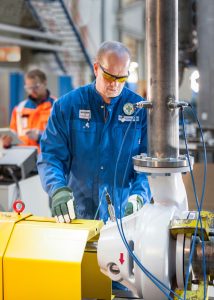
Working closely with experienced materials engineers enables the end user to achieve the most appropriate solution.
For pump manufacturers, the key is to mitigate the corrosion problems by using the most appropriate base material in the construction of the pump. For applications where the use of carbon steel or cast iron is preferred due to cost reasons, the corrosion rate can be estimated very accurately. Based on the mutually accepted corrosion rate per year, the service life of the pump can be anticipated and factored into the maintenance costs of the application.
If the expected corrosion rate is not acceptable the pump materials have to be upgraded to stainless steels which leads to higher costs. In cases where this cost increase is prohibitive, the alternative is to use advanced coatings that can be tailored to suit each application.
If stainless steel is selected for an application, the expected service life is much longer, in some cases infinite. However, this is only true as long as the appropriate stainless steel grade has been chosen for the specific application, it has been produced carefully and is used within the agreed fluid specifications. Special care is required as soon as particles are introduced into the fluid.
In this case even stainless steel becomes susceptible to corrosion due to the passive layer being damaged and the base material becoming activated, which then starts to corrode. Normally the passive layer can be re-established, but if the chloride content is too high or the pH level is too low, the material may remain in an active state and the corrosion continues. Another frequent cause of corrosion in stainless steel pumps are stagnant conditions caused by process interruptions or intermittent operation.
A further threat for stainless steel is chlorine, which is used to combat biological growth in the pump or the connected pipelines. Low level concentrations, around 2 ppm, will have little impact on stainless steel, but it is important to understand how and where the chlorine is introduced into the water flow, to avoid spot concentrations that will damage the protective layer.
Unexpected corrosion can easily negate the anticipated improvement in durability of stainless steel compared to the much cheaper carbon steel variant.
Protective coatings
It is important to determine if the application of coatings will actually improve the performance and the service life of the pump in the first instance and if the costs are really lower than a materials upgrade. In most cases pump manufacturers aim to meet the requirements of a process by using the most appropriate materials for the application and use coatings only as back-up solution.
Polymeric coatings like Fusion Bonded Epoxy can be applied to pump components using a fluidized bed or electrostatic coating. They provide a good level of corrosion protection as long as the coating isn’t damaged. As a polymer coating it is limited to low flow conditions and normally used in clean water applications where it may also improve the hydraulic performance by smoothening the pump surfaces.
However, coatings which are appropriate for pipelines may not be suitable for pump applications where the flow velocities are much higher, narrow passages concentrate the flow and moving parts can be difficult to protect. Again, some methods, such as galvanic protection, commonly used in pipework, are largely unsuitable for pumps.
In these cases coatings are applied to specific areas where increased flow rates are expected or at points where impact damage is expected, such as 90 degree bends. A hard layer is usually applied using a spray coating method such as Air Plasma Spraying (APS), or High Velocity Oxygen Fuel (HVOF) – which one will depend on the required coating thickness and composition.
Carbide coatings, which are deposited by using a high velocity oxy-flame, are extremely wear-resistant. Tungsten carbides in combination with cobalt, nickel or cobalt-chrome matrices are used preferably. Thanks to improvements in the powder and the thermal spray processes, the materials combine high wear-resistance and toughness with good corrosion resistance. Thermal spray coatings can be applied to most substrates, but it is a ‘line-of-sight’ process that makes the coating of complex shaped components, such as impellers, difficult.
CVD processes which are used for complex components that are difficult to coat with thermal spray create very hard surface layers, but are conducted at temperatures in excess of 850 °C. These high temperatures limit the selection of possible substrates, because structural changes and partial deformations can take place during the cooling stage.
Not all coatings are the same
The improvements in performance and durability afforded by coating systems have given rise to a large number of businesses offering a coating service. The raw materials and the basic equipment can be acquired relatively easily and used to apply coatings to a range of equipment.
However, the quality of an HVOF coating, for example, depends predominately on the spraying parameters, such as the material temperature, application velocity, application rate and the quality of the equipment used. Coatings such as these take time to apply correctly, which will inevitably impact on the final cost of the refurbishment. However, increasing the deposition rate will increase the stresses within the coating and over time this can cause the coating to degrade and fail prematurely.
The procedures and settings used by companies such as Sulzer and its coating suppliers have been developed over many years; applying extensive knowledge and experience to the process is the only way to improve it. The final procedure for each coating is closely guarded, proprietary information ensuring that every client will receive the same quality of coating across the world.
To illustrate the importance of these procedures, especially in pump applications, consider the process of installing and removing an impeller. In many situations, the impeller is heated to allow it to be installed or removed from the drive shaft. This shrink-fit procedure can cause inappropriate coatings to be damaged during a routine maintenance operation. Sulzer has ensured that its coating technologies can withstand this thermal shock and continue to deliver long-lasting corrosion protection.
Maintaining legacy equipment
Modern coating technology can be applied to legacy equipment as part of a refurbishment program that will extend the service life of a pump. Implementing a new coating as part of a refurbishment project can significantly improve the performance and reliability of existing equipment.
Ultimately, the key to a successful corrosion prevention scheme is to fully understand the application and to use all the available information to determine the most appropriate action. Working closely with experienced materials engineers enables the end user to achieve the most appropriate solution.
For those looking to refurbish an existing asset there are a number of potential improvements that can extend the service life and improve the performance of a pump. If a new pump design is required, there is an opportunity to establish not only the most appropriate base material, but also the best coating system for extended durability.
The future
As coating technologies continue to advance so end users will be able to select bespoke coatings that can be applied during the manufacturing process. However, even with the most advanced coating, there is a need to develop an application process that can be used to apply the coating to the complex internal surfaces of a cast impeller and volutes. As such, this remains the ‘holy grail’ of pump design and once this challenge is overcome, the reliability and service life of industrial pumps will be further improved.
Improvements in service intervals means reduced maintenance costs and reduced costs attributed to lost production. Together with improved efficiency, these costs of ownership can be minimized through the appropriate use of base materials, protective coatings and the implementation of better pump design to deliver a comprehensive and cost effective pump solution.
About Sulzer
Sulzer is the leading worldwide, independent service provider for the repair and maintenance of rotating machines including turbomachinery, pumps and electro-mechanical equipment. With a global network of over 150 technically advanced manufacturing and test facilities, Sulzer offers a collaborative advantage that delivers high-quality, cost-effective, customized and turnkey solutions, providing its customers with the peace of mind to focus on their core operations.
Sulzer Rotating Equipment Services, a division of Sulzer, can accommodate all brands of rotating equipment including turbines, compressors, generators, motors and pumps. With an enviable track record, dedicated teams of on-site engineers provide best-in-class solutions to ensure that the most effective service is delivered.
Sulzer is dedicated to providing superior service solutions to a range of industries including power generation, oil and gas, hydrocarbon and chemical processing, water and air separation. Every solution is customized to suit the business needs of each application – whenever or wherever that may be.
With a long history of providing engineering service support, Sulzer is headquartered in Winterthur, Switzerland where it began in 1834. Today, with sales over US$ 3 billion and with approximately 15,000 employees, the Sulzer footprint spans across the globe. The core aim is to deliver a flexible and cost-effective service that optimizes customer operational efficiency and minimizes downtime.
For more information on Sulzer, visit www.sulzer.com.

